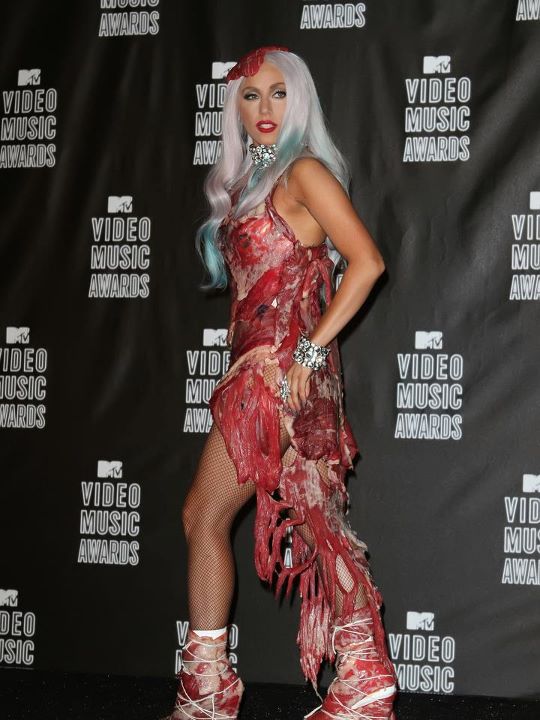Thursday, March 22nd, 2012
A Meaty Post
I belong to a really fantastic book group. This month we have been reading The Sexual Politics of Meat: A Feminist-Vegetarian Critical Theory by Carol J. Adams. This book is really fascinating to me. It explores how meat consumption is related to patriarchal values; meat has longstanding associations with power, strength, virility, and wealth. Adams makes some interesting parallels with how the “masculine” consumption of meat is related to the sexual consumption and objectification of women, too. (You can get a sense of the parallels made between meat and women-as-meat in Adam’s slideshow.) There is a lot more to this book too, and I would highly recommend it to anyone interested in theory, literature, or the history of vegetarianism.
While reading this book, I continually thought of how meat is represented in art and visual culture. Although I have yet to read Adam’s other book, The Pornography of Meat, I feel like I’ve already come up with a substantial list. In many ways, the following representations of meat can also be related to patriarchy and power. I find it telling that the majority of the depictions of meat (that I have come across, at least) were created by men. And I also think it’s interesting that male artists like Rembrandt and Snyder (see below) decided to include women with the carcasses of dead animals. Are these artists merely referencing the fact that women have been delegated the responsibility to prepare meat (for male consumption)? I think we can we make deeper associations between what objects are construed for “the male gaze” in these images, especially from our modern-day perspective.
Along these lines of sexuality and male consumption, it is especially interesting to consider how Snyder depicted the maidservant with birds on a platter. The Dutch word “vogelen” (which means “to bird”) not only refers to fowl, but also to the sexual act. This painting, therefore, seems to reference worldly temptations or physical love.
Artists in the 20th century also were interested in exploring “meaty” subject matter. One work of art that immediately comes to mind is Francis Bacon’s Head Surrounded by Sides of Beef (1954, see below). As an air raid warden in London during WWII, Bacon saw many of the horrors of war (a grisly enterprise which, I think, can be interpreted in many respects as a “masculine” endeavor). With two slabs of meat flanking the sides of a ghostly figure, Bacon explores parallels between meat and death.
Other 20th century artists have made some interesting parallels between meat and male consumption, including the Surrealist artist Meret Oppenheim. Her work, The Governess (see below) depicts a pair of stilletto heels (objects which can signify female sexuality and arousal). The heels are tied together and decorated with paper crowns – the type of decoration sometimes found on a leg of lamb or chicken.
One of the most influential works of art involving meat is Carolee Schneemann’s performance Meat Joy (1964). This performance, which is very aggressive and controversial, involved men and women who danced, rolled on the floor, and played with a mixture of raw flesh (e.g. partially-plucked bloody chickens, raw fish, and raw sausages). The sexual connections between meat and “pleasures of the flesh” are quite clear in the performance.
I also think that it is unsurprising that audience members would squirm during Meat Joy. After all, Schneeman is including bloody and partially-plucked chickens, something that relates to what Carol Adams calls the absent-referent. When people consume animals today, the flesh is usually cooked and modified (and sometimes given a different name than the actual animal, like “veal” or “beef”) to help obscure the reality that a once-living creature has comprised the meal. So, in essence, animals are absent–referents on the dinner table. They are there, but they are also not there. Schneeman’s aggressive reference to flesh and blood in her “happenings” performance restores the absent-referent, which undoubtedly contributed to why viewers squirmed.
Many artists have been influenced by Carolee Schneeman. In fact, in 2008 exhibition titled Meat After Meat Joy brought together the works of various artists who have explored different meanings between meat and flesh. (You can read one blogger’s take on the exhibition here.) One of the videos on display in this exhibition was Zhang Huan’s performance, My New York (2002, see below).
Many of Huan’s performance works involve endurance and masochism. In this particular performance, Huan walked through New York wearing a heavy suit with actual pieces of raw beef. Looking like a “beefed-up” body-builder (which alludes to masculinity and virility!), Huan would occasionally release doves during the performance. It was interesting to interpret this performance in a political light, given the recent 9/11 attacks. The small figure of the artist (within the powerful, beefy costume) was a reflection on how America (and New York itself) were vulnerable – as a nation and as a city.
And finally – I can’t finish this post without a pop culture reference. Lady Gaga has clad herself in “meaty clothes” a few times, once in a meat bikini on the cover of Vogue Hommes Japan. Soon after, Lady Gaga also appeared in a “meat dress” at the 2010 Video Music Awards, complete with a steak on her head (see below).
Although Lady Gaga said in an interview that her dress was a statement about fighting for rights (and asserted “I am not a piece of meat”), I can’t help but see how her dress just reinforces the associations with the masculine consumption of women (which other feminists, including Carol J. Adams, have observed). In this outfit, I think Lady Gaga is suggesting that she is available for consumption on two levels: to satiate sexual and physical hunger. And because of the associations with animals and meat, Lady Gaga seems to reinforce her sexuality by suggesting that she, too, is animalistic.
Any thoughts? Have I spoiled your appetite? (Sorry!) I’m curious to see what other depictions of meat are out there. Do you know of any more? I’m also reminded of Pieter Aertsen’s two works The Butcher’s Stall (1551) and Cook in Front of a Stove (1559). Another example is Van Gogh’s Still Life with Apples, Meat, and a Roll (1886).






Ha! I was hoping you’d mention Lady Gaga. 🙂 Going by what I know of some of her other projects, no matter what she says she’s pretty well-versed in contemporary art and art theory. One of my friends even did a master’s thesis on her.
Have you seen The Supersizers Go? There’s a whole section in the Edwardian episode about vegetarianism and how closely it was connected to women’s suffrage: http://youtu.be/QKpV8yKFY-k
I think images of women holding meat might well refer to the fact that women do most of the cooking (as well as the cleaning, child minding, shopping, laundry etc etc).
But even when dinner was on the table, men usually helped themselves first AND women were usually expected to eat less meat.
SO I also wonder if women in such images might be meaty objects in themselves. Certainly the woman in Frans Snyder’s painting is fully dressed, but then meats can be “dressed” too.
Have a look at Kitchen Scene 1620s by Peter Wtewael. http://www.pubhist.com/work/8400/peter-wtewael/kitchen-scene To me it looks as though the man will first select his meat and then will select the Other White Meat.
Great, thought-provoking post! But a little bit disturbing in the morning.
The one image that pops into my mind is Sarah Lucas’ Chicken Knickers.
http://www.tate.org.uk/servlet/ViewWork?cgroupid=999999961&workid=26391&searchid=11306
In life this photo (can be found at Tate Britain) is way more shocking and it is just right in your face. I believe it embodies your point – and does it from a female’s perspective.
She has a few more of these, with salmon and eggs but I believe this one is her best work.
Have a nice day!
Another popular culture reference is America’s Next Top Model. In cycle 10 (aired in early 2008), Tyra Banks had the ladies do a photo shoot in a NYC meat locker wearing garments made of raw beef. The goal was to be sensual and “fierce” in the photos but I think it’s an interesting conflict- being aroused (or arousing!) and angry at the same time. I guess you could call it kinky.
I can’t help but think of Stanley Spencer’s notorious Double Portrait with Leg of Mutton (1937), which seems to confirm the gender implications you mention. It’s hard to find good reproductions of it online, but it’s included near the bottom of this blog post:
http://mydailyartdisplay.wordpress.com/2011/08/05/double-nude-portrait-by-sir-stanley-spencer/
Ben
Thanks for the comments!
Heidenkind, that clip is so interesting! Carol J. Adams explores connections between suffragettes and vegetarianism. I wonder if her research helped to inform this BBC documentary. I wouldn’t be surprised if that was the case. The book has been around for a long time – it was first published in 1990.
Hels, I love your observation about how women and meat are both “dressed.” Similarly, both women and animals can be “undressed” (such as the plucking of feathers), right? That Wtewael painting is a nice example. I’ve never seen it before. It’s interesting to me that Northern painters were so interested in depicting meat, pantries, kitchen scenes, etc. I wonder why that was the case?
Zsuzsi, thanks for commenting! (And welcome to my blog, I don’t believe that you have commented before.) Wow, that piece by Sarah Lucas is quite interesting, especially from a feminist perspective. I think it’s especially interesting that the female model is cropped (which ties into the “fetishization” of women that was explored by Laura Mulvey). This woman is not an individual at all (we can’t even see her face!). Instead, her body is reduced/cropped and fetishized. The impersonal display of the woman seems to suggest that she, too, is simply “meat” for consumption.
Alli, I’m so glad that you mentioned America’s Top Model. I read somewhere about the meat locker photo shoot a few days ago, but I completely forgot to include it in my post. There is an embedded video of the shoot in this article, which also includes other pop culture references to meat. Another interesting image in that linked article is the original Beatles album cover for “Yesterday and Today.” The controversial cover displays the band with broken baby dolls and slabs of beef.
Ben, thanks for adding another early 20th century example to the list! I wasn’t familiar with this work (or this painter, for that matter). I thought that the writer’s comments about how the cold mutton parallels the “coldness” of the wife’s affections was interesting.
This is a great compilation! If anyone else comes across more “meaty” images, please share!
(spoiler alert)
being part of said book group, i won’t write too much, but peter greenaway’s the cook the thief his wife and her lover (http://www.imdb.com/title/tt0097108/) complicates and plays with these connections between meat/women/consumption/degradation/oppression in interesting ways. the movie takes place mostly in a restaurant, and shots are composed to mirror various dutch still lifes (within which the wife and the lover have sex while her husband stuffs himself in the dining room). there’s a lot to say about it, but in terms of the absent referent, at the end of the film the thief kills the lover by forcing him to eat pages torn out of his own books, stuffing him like a pig fattened for the slaughter. it’s as if the thief, enraged that his wife (as-referent) actually has meaning other than object-for-consumption, is compelled to annihilate all meaning apart from consumption and oppression, which is what he understands and what he controls. however, the wife then subverts the power balance and rejects the status of absent-referent for herself and for the food with which she’s associated by cooking her lover and forcing the thief, who then must confront the horror of his own consumption and the world which he has forcibly emptied of meaning, to eat him. (then she shoots him.)
anyway, great film.
Fascinating post M! To this day, a fine cut of meat is seen as a status symbol, only accessible to the better off – access to certain types of meat in previous eras – before refridgeration etc was even more difficult.
Hence, it is not altogether surprising that meat is associated with patriarchal power. I think of William of Normandy’s funeral, so fat with an excessive lifestyle that there was a great comedy of errors during his burial – then there’s the famous image of a rotund Henry VIII – perhaps the most iconic image of kingly power – and all the more dominating for his bulky frame.
Adding to Zillah’s comments, these themes seem to echo in Peter Greenaway, even beyond “The Cook, The Thief…” – A Zed and Two Noughts is another one of his films that highlights this obsession and includes time lapse animation of decomposition as well as a hearty dose of Greenaways fascination with Vermeer.
One aspect of this discussion which I fear has been omitted due to the approach from social/feminist perspective is graphic depictions of flesh were usually reserved for last judgement type scenes as well as to highlight the violence of Christ’s passion – seen commonly in the Northern Renaissance and extending into the Baroque, particularly becoming quite gruesome in Spain and perhaps visually culminating is Goyas Disasters of War. In this sense it could be said meat was used to demarcate the frailty of mortal flesh, regardless of the gender or politics of anyone encapsulated within it.
For your readers that may be interested – there’s an amazing clip of Andrew Graham Dixon visiting Goya’s house and flipping through the moving ‘Disasters’ in this post at 3PP:
http://www.3pipe.net/2010/10/goyas-black-paintings-journey-into.html
Thanks for the amazing post M!
Kind Regards
H
Food for thought (ha ha).
I am also reading this in the morning, and the thought of any meat besides bacon is a bit too much. But then I thought about that ridiculous Jack in the Box commercial for their bacon cheeseburger where the young man loves bacon so much that he’s going to marry it. He takes the strip of bacon to buy a ring and flowers. Funny how he ends up in the church with the whole burger (a polygamist!). After reading this post, I started thinking about how they cast the meat in the role of the female. It just wouldn’t work if the roles were reversed – it would be too adult and too aggressive. Somehow it’s acceptable for this wholesome young man to eat his bride.
The Oppenheim picture is very powerful. The way the shoes are tied is very suggestive of meat as well as sexual violence.
Great post, M!
wow, what a fascinating topic! i apologize i don’t have any other images to add – and i don’t think i could get my book group to read a book like that for ANYTHING. they’d rather chew broken glass.
Thanks for the comments and suggestions, everyone! It sounds like I’ll need to look into Peter Greenaway’s work, based on what Zillah and H Niyazi said.
Val, I love that you mentioned the Jack in the Box commercial. I actually just saw that last week for the first time. I think that’s a great example of how meat can be “feminized.” The Jack in the Box ads are also appearing in the back of buses in my city. Just this past weekend I saw one that said, “Love Bacon? Marry It.” The hamburger appeared with a little bridal veil. I think one could argue that institution of marriage can be seen as reinforcing patriarchy in some respects…
I was looking at Annibale Carracci’s “Butcher’s Shop” at Christchurch last week.
I’m about to start a module on modern art and the body, so Bacon’s meatiness will be featured. There’s also Chaim Soutine who was obsessed with Rembrandt’s Dead Ox, painting lots of versions of it, and packing his studio with carcasses. Visitors said that they couldn’t stand the smell.
David
Thanks for the comment, David! Your recent post on Annibale Carracci’s “Butcher Shop” is great. Anyone interested in reading the post can find it here:
http://artintheblood.typepad.com/art_history_today/2012/04/a-visit-to-christchurch.html
One more neat site! Check out this post, “Sexualizing and Gendering Food” from “Sociological Images” (The Society Pages). This post has a lot of images that Adam mentions in her two books, “The Sexual Politics of Meat” and “The Pornography of Meat.”
Check out the cover of the book, “Re-framing Representations of Women.” The exposed flesh and bones of the woman’s back evokes that of meat-for-consumption.